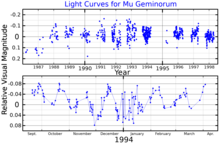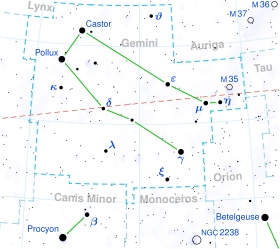Mu Geminorum
| Observation data Epoch J2000.0 Equinox J2000.0 (ICRS) | |
|---|---|
| Constellation | Gemini |
| Right ascension | 06h 22m 57.62686s[1] |
| Declination | +22° 30′ 48.8979″[1] |
| Apparent magnitude (V) | 2.75 - 3.02[2] |
| Characteristics | |
| Evolutionary stage | asymptotic giant branch[3] |
| Spectral type | M3 III[4] |
| U−B color index | +1.924[5] |
| B−V color index | +1.643[5] |
| Variable type | LB[2] |
| Astrometry | |
| Radial velocity (Rv) | +54.38±0.24[6] km/s |
| Proper motion (μ) | RA: +56.39[1] mas/yr Dec.: –110.03[1] mas/yr |
| Parallax (π) | 14.08 ± 0.71 mas[1] |
| Distance | 230 ± 10 ly (71 ± 4 pc) |
| Absolute magnitude (MV) | −1.42[7] |
| Details | |
| Mass | 1.9±0.5[8] M☉ |
| Radius | 107.7[9] R☉ |
| Luminosity | 1,692[10] L☉ |
| Surface gravity (log g) | 0.82±0.09[11] cgs |
| Temperature | 3,643[8] K |
| Metallicity [Fe/H] | −0.03±0.03[11] dex |
| Rotational velocity (v sin i) | 8.4[12] km/s |
| Other designations | |
| Database references | |
| SIMBAD | data |
Mu Geminorum or μ Geminorum, formally named Tejat (/ˈtiːdʒət/),[14] is a single star in the northern constellation of Gemini. From parallax measurements obtained during the Hipparcos mission, it is roughly 230 light-years (71 parsecs) distant from the Sun.[1] The position of the star near the ecliptic means that it is subject to lunar occultations.[15]
Mu Geminorum forms the primary or 'A' component of a double star system designated WDS J06230+2231 along with UCAC2 39641417[16] (also designated WDS J06230+2231BC), itself a binary pair.[17]
Nomenclature

μ Geminorum (Latinised to Mu Geminorum) is the star's Bayer designation. WDS J06230+2231 is the double star's designation in the Washington Double Star Catalog. The designations of the double star's components as WDS J06230+2231A and BC derive from the convention used by the Washington Multiplicity Catalog (WMC) for multiple star systems, and adopted by the International Astronomical Union (IAU).[18]
Mu Geminorum bore the traditional name of Tejat (or more precisely, Tejat Posterior), from an old southern Arabic word of unknown meaning, tiḥyāt.[19] The name Tejat Posterior was formerly applied to an asterism consisting of this star, along with Gamma Geminorum (Alhena), Nu Geminorum, Eta Geminorum (Propus), and Xi Geminorum (Alzirr).[17] In 2016, the International Astronomical Union organized a Working Group on Star Names (WGSN)[20] to catalogue and standardize proper names for stars. The WGSN decided to attribute proper names to individual stars rather than entire multiple systems.[21] It approved the name Tejat for the component WDS J06230+2231A (i.e. Mu Geminorum) on February 1, 2017 and it is now so included in the List of IAU-approved Star Names.[14]
The names Calx (Latin, meaning 'heel'), Pish Pai (from the Persian پیشپای ('pīshpāy', meaning 'foreleg'), and Nuhatai (from Arabic 'Al Nuḥātai', the dual form of 'Al Nuḥāt', 'a Camel's Hump') have also been applied to Mu Geminorum.[22]
In Chinese, 井宿 (Jǐng Su), meaning Well (asterism), refers to an asterism consisting of Mu Geminorum, Gamma Geminorum, Nu Geminorum, Xi Geminorum, Epsilon Geminorum, 36 Geminorum, Zeta Geminorum and Lambda Geminorum.[23] Consequently, Mu Geminorum itself is known as 井宿一 (Jǐng Su yī, English: the First Star of Well).[24]
Properties

Mu Geminorum has an average apparent visual magnitude of about 2.9,[5][2] which makes it the fourth-brightest member of Gemini. It is 0.8 degrees south of the ecliptic, so it is subject to occultations by the Moon and, rarely, by planets.[26] Seen from Earth, its brightness is reduced by 0.07 magnitudes by extinction from intervening gas and dust.[6]
It is a slow irregular variable of type LB. Its brightness varies between magnitude +2.75 and +3.02 over a 72-day period, along with a 2,000-day period of long term variation. It is a red giant at a stellar classification of M3 III,[4] with a surface temperature of 3,773 K,[27] meaning it is brighter, yet cooler, than the Sun.[2][17] The star is currently on the asymptotic giant branch and is generating energy through the nuclear fusion of hydrogen and helium along concentric shells surrounding an inert core of carbon and oxygen.[3]
Notes
References
- ^ a b c d e f van Leeuwen, F. (November 2007), "Validation of the new Hipparcos reduction", Astronomy and Astrophysics, 474 (2): 653–664, arXiv:0708.1752, Bibcode:2007A&A...474..653V, doi:10.1051/0004-6361:20078357, S2CID 18759600.
- ^ a b c d mu Gem, entry in the Combined General Catalog of Variable Stars (GCVS 5.1), N. N. Samus, O. V. Durlevich, et al., database identifier B/gcvs at the Centre de Données astronomiques de Strasbourg.
- ^ a b Lebzelter, T.; Hron, J. (January 2008), "BRITE stars on the AGB", Communications in Asteroseismology, 152: 178–181, Bibcode:2008CoAst.152..178L, doi:10.1553/cia152s178.
- ^ a b Morgan, W. W.; Keenan, P. C. (1973), "Spectral Classification", Annual Review of Astronomy and Astrophysics, 11: 29, Bibcode:1973ARA&A..11...29M, doi:10.1146/annurev.aa.11.090173.000333.
- ^ a b c Gutierrez-Moreno, Adelina; et al. (1966), "A System of photometric standards", Publications of the Department of Astronomy University of Chile, 1, Publicaciones Universidad de Chile, Department de Astronomy: 1–17, Bibcode:1966PDAUC...1....1G.
- ^ a b Famaey, B.; et al. (January 2005), "Local kinematics of K and M giants from CORAVEL/Hipparcos/Tycho-2 data. Revisiting the concept of superclusters", Astronomy and Astrophysics, 430 (1): 165–186, arXiv:astro-ph/0409579, Bibcode:2005A&A...430..165F, doi:10.1051/0004-6361:20041272, S2CID 17804304.
- ^ Schiavon, Ricardo P. (July 2007), "Population Synthesis in the Blue. IV. Accurate Model Predictions for Lick Indices and UBV Colors in Single Stellar Populations", The Astrophysical Journal Supplement Series, 171 (1): 146–205, arXiv:astro-ph/0611464, Bibcode:2007ApJS..171..146S, doi:10.1086/511753, S2CID 13946698.
- ^ a b Halabi, Ghina M.; Eid, Mounib El (2015-08-01). "Exploring masses and CNO surface abundances of red giant stars". Monthly Notices of the Royal Astronomical Society. 451 (3): 2957–2967. arXiv:1507.01517. Bibcode:2015MNRAS.451.2957H. doi:10.1093/mnras/stv1141. ISSN 0035-8711.
- ^ Wood, Brian E.; Müller, Hans-Reinhard; Harper, Graham M. (2016-09-23), "Hubble Space Telescope Constraints on the Winds and Astrospheres of Red Giant Stars", The Astrophysical Journal, 829 (2): 74, arXiv:1607.07732, Bibcode:2016ApJ...829...74W, doi:10.3847/0004-637X/829/2/74, ISSN 0004-637X
- ^ Lee, Byeong-Cheol; Do, Hee-Jin; et al. (October 2023). "Long-period radial velocity variations of nine M red giants: The detection of sub-stellar companions around HD 6860 and HD 112300". Astronomy & Astrophysics. 678: A106. arXiv:2307.15897. Bibcode:2023A&A...678A.106L. doi:10.1051/0004-6361/202243725.
- ^ a b Wu, Yue; Singh, H. P.; Prugniel, P.; Gupta, R.; Koleva, M. (2011-01-01), "Coudé-feed stellar spectral library - atmospheric parameters", Astronomy and Astrophysics, 525: A71, arXiv:1009.1491, Bibcode:2011A&A...525A..71W, doi:10.1051/0004-6361/201015014, ISSN 0004-6361
- ^ Massarotti, Alessandro; et al. (January 2008), "Rotational and Radial Velocities for a Sample of 761 HIPPARCOS Giants and the Role of Binarity", The Astronomical Journal, 135 (1): 209–231, Bibcode:2008AJ....135..209M, doi:10.1088/0004-6256/135/1/209, S2CID 121883397.
- ^ "mu. Gem", SIMBAD, Centre de données astronomiques de Strasbourg, retrieved October 12, 2007.
- ^ a b Naming Stars, IAU.org, retrieved 16 December 2017.
- ^ Mondal, Soumen; Chandrasekhar, T. (August 2005), "Angular Diameter Measurements of Evolved Variables by Lunar Occultations at 2.2 and 3.8 Microns", The Astronomical Journal, 130 (2): 842–852, arXiv:astro-ph/0504326, Bibcode:2005AJ....130..842M, doi:10.1086/430457, S2CID 14802944.
- ^ "UCAC2 39641417 -- Double or multiple star", SIMBAD, Centre de Données astronomiques de Strasbourg, retrieved 2018-07-28.
- ^ a b c Tejat, Jim Kaler's STARS, retrieved 2017-03-31.
- ^ Hessman, F. V.; Dhillon, V. S.; Winget, D. E.; Schreiber, M. R.; Horne, K.; Marsh, T. R.; Guenther, E.; Schwope, A.; Heber, U. (2010), On the naming convention used for multiple star systems and extrasolar planets, arXiv:1012.0707.
- ^ Kunitzsch, Paul; Smart, Tim (2006), A Dictionary of Modern star Names: A Short Guide to 254 Star Names and Their Derivations (2nd rev. ed.), Cambridge, Massachusetts: Sky Pub, ISBN 978-1-931559-44-7.
- ^ "International Astronomical Union | IAU", www.iau.org, retrieved 2017-04-01.
- ^ WG Triennial Report (2015-2018) - Star Names (PDF), p. 5, retrieved 2018-07-14.
- ^ Allen, Richard Hinckley (1899), Star-names and Their Meanings, G. E. Stechert, p. 236.
- ^ (in Chinese) 中國星座神話, written by 陳久金. Published by 台灣書房出版有限公司, 2005, ISBN 978-986-7332-25-7.
- ^ (in Chinese) 香港太空館 - 研究資源 - 亮星中英對照表 Archived 2010-08-19 at the Wayback Machine, Hong Kong Space Museum. Accessed on line November 23, 2010.
- ^ Percy, John R.; Wilson, Joseph B.; Henry, Gregory W. (August 2001), "Long-Term VRI Photometry of Small-Amplitude Red Variables. I. Light Curves and Periods", Publications of the Astronomical Society of the Pacific, 113 (786): 983–996, Bibcode:2000AAS...197.4614P, doi:10.1086/322153, JSTOR 10.1086/322153, S2CID 14609175.
- ^ White, Nathaniel M.; Feierman, Barry H. (September 1987), "A Catalog of Stellar Angular Diameters Measured by Lunar Occultation", Astronomical Journal, 94: 751, Bibcode:1987AJ.....94..751W, doi:10.1086/114513.
- ^ Mallik, Sushma V. (December 1999), "Lithium abundance and mass", Astronomy and Astrophysics, 352: 495–507, Bibcode:1999A&A...352..495M.

